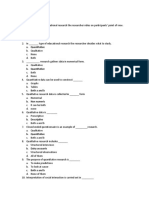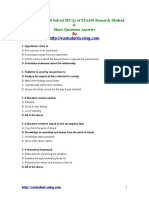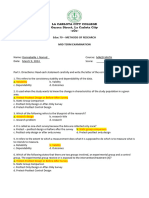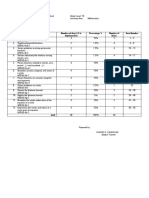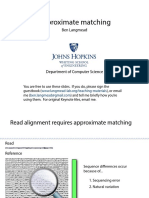92%(12)92% found this document useful (12 votes)
11K viewsMCQ Research Design
MCQ Research Design
Uploaded by
ABHIJIT S. SARKARThis document discusses key concepts in research design and methodology. It covers topics like research hypotheses, qualitative and quantitative research, variables, experimental and non-experimental designs, sampling techniques, data collection and analysis methods, and validity and reliability. Some key points covered are that hypotheses in qualitative research are often generated during data collection and analysis, mixed methods research uses both qualitative and quantitative approaches, and variables can be independent, dependent or confounding.
Copyright:
© All Rights Reserved
Available Formats
Download as DOCX, PDF, TXT or read online from Scribd
MCQ Research Design
MCQ Research Design
Uploaded by
ABHIJIT S. SARKAR92%(12)92% found this document useful (12 votes)
11K views10 pagesThis document discusses key concepts in research design and methodology. It covers topics like research hypotheses, qualitative and quantitative research, variables, experimental and non-experimental designs, sampling techniques, data collection and analysis methods, and validity and reliability. Some key points covered are that hypotheses in qualitative research are often generated during data collection and analysis, mixed methods research uses both qualitative and quantitative approaches, and variables can be independent, dependent or confounding.
Original Description:
mcq brm uop
Copyright
© © All Rights Reserved
Available Formats
DOCX, PDF, TXT or read online from Scribd
Share this document
Did you find this document useful?
Is this content inappropriate?
This document discusses key concepts in research design and methodology. It covers topics like research hypotheses, qualitative and quantitative research, variables, experimental and non-experimental designs, sampling techniques, data collection and analysis methods, and validity and reliability. Some key points covered are that hypotheses in qualitative research are often generated during data collection and analysis, mixed methods research uses both qualitative and quantitative approaches, and variables can be independent, dependent or confounding.
Copyright:
© All Rights Reserved
Available Formats
Download as DOCX, PDF, TXT or read online from Scribd
Download as docx, pdf, or txt
92%(12)92% found this document useful (12 votes)
11K views10 pagesMCQ Research Design
MCQ Research Design
Uploaded by
ABHIJIT S. SARKARThis document discusses key concepts in research design and methodology. It covers topics like research hypotheses, qualitative and quantitative research, variables, experimental and non-experimental designs, sampling techniques, data collection and analysis methods, and validity and reliability. Some key points covered are that hypotheses in qualitative research are often generated during data collection and analysis, mixed methods research uses both qualitative and quantitative approaches, and variables can be independent, dependent or confounding.
Copyright:
© All Rights Reserved
Available Formats
Download as DOCX, PDF, TXT or read online from Scribd
Download as docx, pdf, or txt
You are on page 1of 10
Research Design
1) Research hypotheses are ------------------
a. Formulated prior to a review of the literature
b. Statements of predicted relationships between variables
c. Stated such that they can be confirmed or refuted
d. Both b and c
2) Hypothesis in qualitative research studies usually ------------
a. Are very specific and stated prior to beginning the study
b. Are often generated as the data are collected, interpreted and analyzed
c. Are never used
d. Are always stated after the research study has been completed
3. Research in which the researcher uses the qualitative paradigm for one phase and the
quantitative paradigm for another phase is known as -----------
a. Action research
b. Basic research
c. Quantitative research
d. Mixed method research
4. Qualitative research is often exploratory and has all of the following characteristics except--------
a. It is typically used when a great deal is already known about the topic of interest
b. It relies on the collection of non numerical data such as words and pictures
c. It is used to generate hypotheses and develop theory about phenomena in the world
d. It uses the inductive scientific method
5. The opposite of a variable ---------
a. A constant
b. An extraneous variable
c. A dependent variable
d. A data set
6. A variable that is presumed to cause a change in another variable is called as -------------
a. Categorical variable
b. Dependent variable
c. Independent variable
d. Intervening variable
7. A condition or characteristic that can take on different values or categories is called -------------
a. A constant
b. A variable
c. A cause-and-effect relationship
d. A descriptive relationship
8. The quantitative research is best described by----------
a. The collection of non numerical data
b. An attempt to confirm the researchers hypotheses
c. Research that is exploratory
d. Research that attempts to generate new theory
9. ------------ allow a researcher to examine the degree and direction of the relationship between 2
characteristics or variables
a. Correlational designs
b. Quasi-experimental designs
c. Confounding variables
d. Experimental designs
10. A dependent variable refers to -----------------
a. The experimental condition
b. The variable which shows us the effect of the manipulation
c. The variable being manipulated or varied in some way by the researcher
d. A variable with a single value which remains constant in a particular context
11. Variables are ---------------
a. The main focus of research in science
b. Something that can vary in terms of precision
c. Something that we can measure
d. All of the above
12. The sort of variable manipulated by the researcher is -------
a. Dependent
b. C0-dependent
c. Independent
d. All variables are manipulated by the researcher
13. The null and alternative hypotheses divide all possibilities into---------
a. Two sets that overlap
b. Two non-overlapping sets
c. Two sets that may or may not overlap
d. As many sets as necessary to cover all possibilities
14. -------------- is true of the null and alternative hypotheses
a. Exactly one hypothesis must be true
b. Both hypotheses must be true
c. It is possible for both hypotheses to be true
d. It is possible for neither hypothesis to be true
15. The form of the alternative hypothesis can be
a. one-tailed
b. Two-tailed
c. Neither one nor two tailed
d. One or two-tailed
16. The alternative hypothesis is also known as the
a. Elective hypothesis
b. Optional hypothesis
c. Research hypothesis
d. Null hypothesis
17. A Type II error is also known as a ---------
a. False positive
b. False negative
c. Double negative
d. Positive negative
18. A type I error is also known as ----------------
a. False positive
b. False negative
c. Double negative
d. Positive negative
19. ------- is the failure to reject a false null hypothesis
a. Type I error
b. Type II error
c. Type A error
d. Type B error
20. Which of the following statements is/are true according to the logic of hypothesis testing?
a. When the null hypothesis is true, it should be rejected
b. When the null hypothesis is true, it should not be rejected
c. When the null hypothesis is false, it should be rejected
d. Both b and c are true
21. A literature review requires
a. Planning
b. Good and clear writing
c. Lot of rewriting
d. All of the above
22. Conducting surveys is the most common method of generating ------------
a. Primary data
b. Secondary data
c. Qualitative data
d. None of the above
23. A list of questions which is handled over to the respondent, who reads the questions and records
the answers himself is known as the -------
a. Interview schedule
b. Questionnaire
c. Interview guided
d. All of the above
24. Exploratory research addresses one of the following types of question
a. If
b. How
c. Why
d. What
25. Hypotheses test may also be called as
a. Informal test
b. Significance test
c. Moderating test
d. t-test
26. The interview in which questions are already prepared is called -------------
a. Telephone interview
b. Personal interview
c. Unstructured interview
d. Structured interview
27. The group that does not receive the experimental treatment condition is the -------------
a. Experimental group
b. Control group
c. Treatment group
d. Independent group
28. There is a number of ways in which confounding extraneous variables can be controlled. Which
control technique is considered to be the best?
a. Random assignment
b. Matching
c. Counterbalancing
d. None of the above
29. A cell is a combination of 2 or more ------------ in a factorial design
a. Research designs
b. Research measurements
c. Dependent variables
d. Independent variables
30. A factorial design is one in which--------------
a. Only one independent variable is studied to determine its effect on the dependent variable
b. Only two independent variables are simultaneously studied to determine their independent and
interactive effects on the dependent variables
c. Two or more independent variables are simultaneously studied to determine their independent
and interactive effects on the dependent variable
d. Two dependent variables are studied to determine their interactive effects
31. A researcher is interested in the effects of a preschool program on later school performance.
Because she is concerned that Socio-Economic-Status(SES) is a potential extraneous variable in her
study, she picks children to study who are only from low SES homes. The control technique she used
in this study was -------
a. Matching
b. Random assignment
c. Holding the extraneous variable constant
d. Statistically controlling the extraneous variable
32. The directors of a graduate program in educational research wish to see what types of jobs their
graduates take after they finish their program. They randomly sample students from the program
and have them fill out questionnaires with items asking about the types of jobs they have had. They
also are asked to describe the roles they play in their current positions. This project is best described
as having what kind of objective-----------
a. Descriptive
b. Predictive
c. Explanatory
d. None of the above
33. The variable the researcher matches to eliminate it as an alternative explanation is called a -------
------ variable.
a. Matching
b. Independent
c. Dependent
d. Partial
34. Which of the following is not a longitudinal design?
a. Panel
b. Cross-Sectional
c. Trend
d. Both a and c are longitudinal designs
35. In qualitative research, differences among types of purposive sample have to do with----------
a. Representativeness
b. Timing during the study
c. Individual variability
d. All of the above
36. Data analysis in qualitative research, as contrasted with quantitative research is generally
a. Theoretical rather than applied
b. Applied rather than theoretical
c. Deductive rather than inductive
d. Inductive rather than deductive
37. Qualitative researchers view changes in procedures during a study as ---------------
a. A weakness
b. Frustrating
c. A good thing
d. To be avoided
38. Conclusions from qualitative research are --------
a. Less certain than from quantitative research
b. Of little practical use
c. Seldom defensible
d. Of descriptive value only
39. The validity poses a problem for qualitative research because-------------
a. Because the measurement of validity implies that there is something fixed which can be
measured
b. Because the validity of interviews cannot be measured
c. Because the validity is only an issue in quantitative research
d. Because there isnt any quantitative data on which to assess validity
40. The weakness of quantitative research is ---------
a. Provides precise, numerical data
b. The researchers categories that are used might not reflect local constituencies understandings
c. Testing hypotheses that are constructed before the data are collected
d. Can study a large number of people.
41. A study in which quantitative and qualitative data are collected at the same time is a -----------
a. Concurrent mixed method design
b. Mixed method design
c. Sequential mixed method design
d. Cross-sectional mixed method design
42. The starting point for a literature search is ----
a. Tertiary data
b. Primary data
c. Secondary data
d. Some other data
43. The researcher is usually interested in supporting ------when he or she is engaging in hypothesis
testing
a. The alternative hypothesis
b. The null hypothesis
c. Both the alternative and null hypothesis
d. Neither the alternative or null hypothesis
44. The cutoff the researcher uses to decide whether to reject the null hypothesis is called the -----
a. Significance level
b. Alpha level
c. Probability value
d. Both a and b are correct
45. Of type I and II error , one which traditionally regarded as more serious is ------
a. Type I
b. Type II
c. They are equally serious
d. Neither is serious
46. Smaller p-values indicate more evidence in support of ------
a. The null hypothesis
b. The alternative hypothesis
c. The quality of the researcher
d. Further testing
47.A null hypothesis can only be rejected at the 5% significance level if and only if ------
a. A 95% confidence interval includes the hypothesized value of the parameter
b. A 95% confidence interval does not include the hypothesized value of the parameter
c. The null hypothesis is void
d. The null hypotheses includes sampling error
48.A developmental research design that examines age differences at only one point in time is called
the ------ method
a. Cross-sectional
b. Longitudinal
c.Single-case
d. Sequential
49. ----------- is used to achieve equivalence between the groups of participants.
a. Random assignment
b.Random selection
c. Probability sampling
d. Simple random sampling
50. By using the experimental method, extraneous variables are kept constant either though --------
or through ---------------.
a. Confounding randomization; blind experimenters
b. Experimental control; randomization
c. Random sampling; random assignment
d. The independent variable; the dependent variable
You might also like
- More Than 2000 Solved MCQs On Research MethodsDocument130 pagesMore Than 2000 Solved MCQs On Research MethodsRama Nathan86% (216)
- MCQ 100Document17 pagesMCQ 100Ankit Dubey76% (111)
- 2000 Solved MCQs of Research Method Short Question Answers PDFDocument327 pages2000 Solved MCQs of Research Method Short Question Answers PDFVidhya Sivaramganesh67% (3)
- Research Methodology MCQ 180629120038 PDFDocument95 pagesResearch Methodology MCQ 180629120038 PDFbmk2k450% (2)
- Research Methodology 700Document55 pagesResearch Methodology 700sahilssm17No ratings yet
- Qualitative MCQs Final With KeyDocument19 pagesQualitative MCQs Final With KeyAhmad Raza100% (5)
- Decision Science - MCQ UOPDocument52 pagesDecision Science - MCQ UOPABHIJIT S. SARKAR82% (28)
- RM 240 MCQs BBAIV Sakshi 60 MCQs Each UnitsDocument54 pagesRM 240 MCQs BBAIV Sakshi 60 MCQs Each Unitstarun KaushikNo ratings yet
- Research Paper MCQ 2Document72 pagesResearch Paper MCQ 2AamirKhanMohmandNo ratings yet
- Research Methods MCQs 2Document5 pagesResearch Methods MCQs 2Asad Ali87% (23)
- Research Methodology MCQ of Pune UniversityDocument22 pagesResearch Methodology MCQ of Pune UniversityABHIJIT S. SARKAR86% (22)
- STA630 Research Methods MCQs VUABIDDocument36 pagesSTA630 Research Methods MCQs VUABIDJasmy PaulNo ratings yet
- Research Methodology MCQDocument18 pagesResearch Methodology MCQnamita Rane86% (7)
- STA630 Research Methods MCQs VUABIDDocument33 pagesSTA630 Research Methods MCQs VUABIDsaeedsjaan84% (83)
- Research Methodology Multiple Choice QuestionsDocument313 pagesResearch Methodology Multiple Choice QuestionsTariq Hussain Khan89% (247)
- RM MCQDocument27 pagesRM MCQmigaseNo ratings yet
- Research Methodology MCQ of Pune UniversityDocument22 pagesResearch Methodology MCQ of Pune UniversityABHIJIT S. SARKAR86% (22)
- Marketing Management MCQ Pune UniDocument32 pagesMarketing Management MCQ Pune UniABHIJIT S. SARKAR86% (7)
- MCQ RMDocument16 pagesMCQ RMamarpoonam89% (9)
- Research Methodology MCQSDocument4 pagesResearch Methodology MCQSFari Art and CraftNo ratings yet
- Research Method Sta630 Solved Mcqs byDocument33 pagesResearch Method Sta630 Solved Mcqs byayaz14395% (19)
- RM MCQ (1) B.com - 0Document25 pagesRM MCQ (1) B.com - 0San DiogoNo ratings yet
- More Than 2000 Solved MCQs On Research Methodology - 1Document14 pagesMore Than 2000 Solved MCQs On Research Methodology - 1JAGANNATH PRASAD100% (2)
- More Than 2000 Solved MCQsof STA630 Research Method Short Question AnswerDocument337 pagesMore Than 2000 Solved MCQsof STA630 Research Method Short Question AnswerbalachmalikNo ratings yet
- Research (MCQ)Document30 pagesResearch (MCQ)bijay86% (22)
- Sta 630 Research Methods Solved MCQ SDocument21 pagesSta 630 Research Methods Solved MCQ SBilal Ahmad86% (7)
- Research Methodology MCQDocument101 pagesResearch Methodology MCQHafiz Saddique Malik100% (2)
- Research Methodology MCQDocument8 pagesResearch Methodology MCQCh Tahir MasoodNo ratings yet
- Research Methodology MCQ 400Document190 pagesResearch Methodology MCQ 400dhanusiya balamurugan70% (20)
- Research Methods QuizDocument51 pagesResearch Methods Quizasim100% (1)
- Research Methodology MCQ (Multiple Choice Questions) - JavaTpointDocument26 pagesResearch Methodology MCQ (Multiple Choice Questions) - JavaTpointAshok Kumar Rajanavar100% (1)
- RM Chapterwise MCQDocument38 pagesRM Chapterwise MCQABHIJIT S. SARKAR71% (7)
- Research Methodology MCQDocument28 pagesResearch Methodology MCQAjish Joy100% (1)
- Research Methodology MCQ Questions Set-5: Answer (B) A Specific Area and Tries To Understand It in Minute DetailsDocument35 pagesResearch Methodology MCQ Questions Set-5: Answer (B) A Specific Area and Tries To Understand It in Minute DetailsAditya Kumbhar100% (1)
- Research Methodology MCQ Questions and Answers PDFDocument17 pagesResearch Methodology MCQ Questions and Answers PDFZaka Malik100% (2)
- MCQS Question: Qualitative ResearchDocument5 pagesMCQS Question: Qualitative ResearchAshley33% (3)
- More Than 2000 Solved MCQs On Research MethodsDocument127 pagesMore Than 2000 Solved MCQs On Research MethodsBhushan Chaudhari100% (2)
- MB0050 Research Methodology MQPDocument27 pagesMB0050 Research Methodology MQPdev_doon123100% (6)
- Research Methodology MCQ..Document20 pagesResearch Methodology MCQ..Anseeta SajeevanNo ratings yet
- Research Methodology MCQ (Multiple Choice Questions) - JavaTpointDocument25 pagesResearch Methodology MCQ (Multiple Choice Questions) - JavaTpointkaranvir singh100% (1)
- MB0034-Research Methodology - Model Question PaperDocument24 pagesMB0034-Research Methodology - Model Question PaperAvinash Kumar83% (36)
- Research Methodology MCQ With Answer 100 QuestionsDocument12 pagesResearch Methodology MCQ With Answer 100 QuestionsvandyNo ratings yet
- 40 Solved MCQs of STA630 - Research MethodsDocument14 pages40 Solved MCQs of STA630 - Research MethodsPower Girls84% (141)
- Research Methodology MCQ Questions and Answers PDFDocument18 pagesResearch Methodology MCQ Questions and Answers PDFclement6984No ratings yet
- RM One MarksDocument27 pagesRM One MarksMANISH BORANA.R vetias100% (2)
- Research Methodologymcq1 1Document10 pagesResearch Methodologymcq1 1AARTI PRABHAKAR BOGANo ratings yet
- Research Methodology MCQ WordDocument13 pagesResearch Methodology MCQ WordEnbathamizhan100% (1)
- Research Methodology MCQ's & AnswersDocument37 pagesResearch Methodology MCQ's & AnswersSiqiniseko GumbiNo ratings yet
- Research Methodology MCQ Questions With AnswersDocument48 pagesResearch Methodology MCQ Questions With AnswersPriyam Choksi100% (5)
- Research Solved MCQDocument18 pagesResearch Solved MCQBheru Lal100% (3)
- Research MCQDocument29 pagesResearch MCQVinoth Selvaraj67% (3)
- MCQ Research DesignDocument10 pagesMCQ Research DesignharibhagatNo ratings yet
- Questions of MSWDocument10 pagesQuestions of MSWKrishna Veni Senthil KumarNo ratings yet
- Paper IIDocument13 pagesPaper IIKisha NelsonNo ratings yet
- Practical Research 2 Reviewer 01Document3 pagesPractical Research 2 Reviewer 01Norberto Satuita100% (1)
- Business Research MCQDocument8 pagesBusiness Research MCQMD Rehan100% (1)
- LCCC Educ 97 Mid Term ExamDocument7 pagesLCCC Educ 97 Mid Term Examdonnabelle isidroNo ratings yet
- Resa ErchDocument36 pagesResa ErchROHITNo ratings yet
- RMS QuizDocument12 pagesRMS QuizSara peelNo ratings yet
- III 3nd Quarter Exam 20231Document4 pagesIII 3nd Quarter Exam 20231Jiez CastorNo ratings yet
- TRIAL QUESTIONS ResearchDocument30 pagesTRIAL QUESTIONS ResearchAmoah SamuelNo ratings yet
- Business Research McqsDocument36 pagesBusiness Research McqsKofi AsaaseNo ratings yet
- Post-Test Research 2022Document6 pagesPost-Test Research 2022Rubie PajarillaNo ratings yet
- Research Designs - 6 ItemsDocument3 pagesResearch Designs - 6 ItemsPamela GalveNo ratings yet
- 413mkt e MarketingDocument1 page413mkt e MarketingABHIJIT S. SARKARNo ratings yet
- Chi-Square Test of IndependenceDocument3 pagesChi-Square Test of IndependenceABHIJIT S. SARKARNo ratings yet
- MCQ-Startup & New VentureDocument10 pagesMCQ-Startup & New VentureABHIJIT S. SARKAR60% (5)
- Strategic ManagementDocument9 pagesStrategic ManagementABHIJIT S. SARKARNo ratings yet
- Study of Assessment Methods of Working Capital RequirementDocument92 pagesStudy of Assessment Methods of Working Capital RequirementABHIJIT S. SARKARNo ratings yet
- Eabd - MCQ (Unit-2)Document11 pagesEabd - MCQ (Unit-2)ABHIJIT S. SARKAR75% (4)
- 202 - MCQ - 1Document14 pages202 - MCQ - 1ABHIJIT S. SARKAR50% (2)
- How To Prepare Dissertation - MbaDocument22 pagesHow To Prepare Dissertation - MbaABHIJIT S. SARKAR100% (2)
- RM Chapterwise MCQDocument38 pagesRM Chapterwise MCQABHIJIT S. SARKAR71% (7)
- S. B. Patil Institute of Management: Question Bank MBA-II SemDocument2 pagesS. B. Patil Institute of Management: Question Bank MBA-II SemABHIJIT S. SARKARNo ratings yet
- HRM MCQ UopDocument47 pagesHRM MCQ UopABHIJIT S. SARKAR0% (1)
- Debtors ManagementDocument61 pagesDebtors ManagementAbhishek KumarNo ratings yet
- Maths Word Problems and SolutionsDocument48 pagesMaths Word Problems and Solutionssheilamariedacut0% (1)
- The Fibonacci Numbers and Golden Section in Nature - 1Document20 pagesThe Fibonacci Numbers and Golden Section in Nature - 1Himadri ChakrabortiNo ratings yet
- IEEE Paper Format TemplateDocument2 pagesIEEE Paper Format TemplateRijul SaxenaNo ratings yet
- Power Quality in The Age of Leds: Part 4: by Guy HoltDocument5 pagesPower Quality in The Age of Leds: Part 4: by Guy Holtreza qesNo ratings yet
- Math 10Document3 pagesMath 10Mary Joselyn BodionganNo ratings yet
- Chapter 7 - Stresses in Beams - Part 1 - Mark Ups LectureDocument58 pagesChapter 7 - Stresses in Beams - Part 1 - Mark Ups LecturelarraNo ratings yet
- Model Theory Cheat SheetDocument11 pagesModel Theory Cheat SheetOğul Can YurdakulNo ratings yet
- Handout On CardinalityDocument3 pagesHandout On CardinalityLicht ZoraNo ratings yet
- Time TableDocument1 pageTime TableTamil SelvaNo ratings yet
- TOPSIS Method: X (X X XDocument2 pagesTOPSIS Method: X (X X XRajaa KodadNo ratings yet
- APPLICATION 6 Moment of InertiaDocument44 pagesAPPLICATION 6 Moment of InertiaAnais RosalNo ratings yet
- Subject Verb Agreement RulesDocument4 pagesSubject Verb Agreement RulesTay Kai XianNo ratings yet
- TextbooksDocument482 pagesTextbooksJuan PertuzNo ratings yet
- Basic Research TerminologyDocument14 pagesBasic Research TerminologyDanyal KhanNo ratings yet
- Reference: Digital Signal Processing Laboratory Using Matlab Author: Sanjit K. MitraDocument16 pagesReference: Digital Signal Processing Laboratory Using Matlab Author: Sanjit K. Mitraabdul.azeezNo ratings yet
- Fire Risk Assessment For Super High-Rise BuildingsDocument10 pagesFire Risk Assessment For Super High-Rise BuildingsAnjani Kumar SinghNo ratings yet
- Assignment 2 PDFDocument5 pagesAssignment 2 PDFMUHAMMAD HAFIZUDDINNo ratings yet
- Ce 107 - Module 5 - Cables and ArchesDocument7 pagesCe 107 - Module 5 - Cables and Archesavelinokenandrew30No ratings yet
- 3.iai Unit-III First-Order LogicDocument44 pages3.iai Unit-III First-Order Logicsandhyabandaru89No ratings yet
- Ale-Idoc Inbound FMDocument34 pagesAle-Idoc Inbound FMKumaresh KararNo ratings yet
- Derivation Tapered Beam Stiffnss MatrixDocument5 pagesDerivation Tapered Beam Stiffnss MatrixPavan Kishore100% (1)
- DFA Minimisation Using The Myhill-Nerode TheoremDocument10 pagesDFA Minimisation Using The Myhill-Nerode TheoremTomás HernándezNo ratings yet
- Lilavati Book by Bhaskaracharya PDFDocument4 pagesLilavati Book by Bhaskaracharya PDFRajesh Kumar50% (2)
- Chapter 18 Presentation of InformationDocument2 pagesChapter 18 Presentation of InformationVincent ChurchillNo ratings yet
- Approximate MatchingDocument16 pagesApproximate Matchingskgcp864355No ratings yet
- C&I TriDocument5 pagesC&I TrisandeepNo ratings yet
- LN JXBH 4 Aw BHwot Fo Ku 2 UDocument6 pagesLN JXBH 4 Aw BHwot Fo Ku 2 Usudarshan76072No ratings yet
- Uet Signals Lab Manual PDFDocument81 pagesUet Signals Lab Manual PDFsaran gulNo ratings yet
- Designing The Medieval New TownDocument14 pagesDesigning The Medieval New TownTuğman BüberciNo ratings yet
- HP-10C Owner's Handbook 1982 ColorDocument128 pagesHP-10C Owner's Handbook 1982 Colorjjirwin100% (1)


















